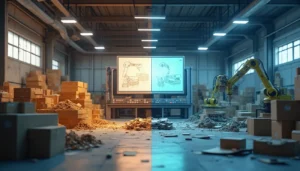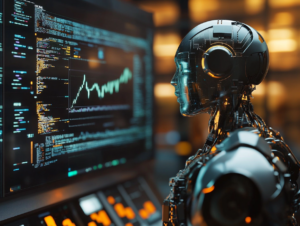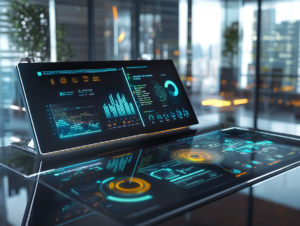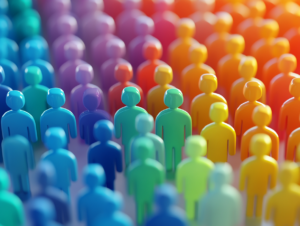We live in a time of rapid tech changes. Artificial intelligence (AI) is now a game changer in product design and innovation. It’s not just a tool anymore. AI has become a key partner in creating new things, pushing what we thought was possible, and changing industries. Picture a world where every product fits your exact needs. This dream is turning real, with AI leading the charge. Let’s see how AI is changing product design and innovation from start to finish.
AI-Driven Brainstorming: Sparking New Ideas
AI is changing the game for traditional brainstorming sessions. These sessions used to be limited by what people could imagine and the resources they had. Now, AI tools can look at huge amounts of data, including market trends and how consumers behave, to develop new product ideas. Take generative design algorithms as an example. They use complex data to suggest new design solutions that might not come up in regular brainstorming. This has a big impact on how we think up new ideas.
Picture this: designers punch in some details into an AI tool, and in a flash, it spits out a bunch of clever product ideas. This doesn’t just speed up brainstorming—it brings a fresh spark that can open up whole new paths to explore. When companies can come up with and tweak ideas, they get to try out way more options, which leads to cooler, more effective product designs.
Personalized Design at Scale: Meeting Individual Needs
Today’s shoppers want products that fit their specific tastes. AI makes this happen by allowing mass customization so brands can give personalized experiences to many people. AI-powered systems that make suggestions look at each shopper’s data to propose product changes that make things more relevant to them.
Take this example: an AI system might check what someone bought before, what they looked at online, and what they do on social media. Then, it can adjust a product’s features and look to match what that person likes. This kind of customization doesn’t just make customers happier—it also makes them more loyal to brands because they feel understood and important. Being able to offer custom products to lots of people is a big deal for companies trying to stand out in a busy market.
Enhanced Prototyping and Testing: Accelerating Development
Prototyping and testing play a key role in product development, and AI impacts these processes. The old way of prototyping can take a lot of time and money, often requiring many tries to improve a design. AI speeds this up by using predictive analytics to model how a product will work in different situations before building real prototypes.
AI-powered simulations let designers test various scenarios and spot potential problems. This ability to predict speeds up prototyping and cuts down on costs linked to physical testing. By fine-tuning design factors and forecasting results, AI ensures the end product works well and efficiently meets quality benchmarks and what consumers want.
Data-Driven Decision-Making: Guiding Product Development
In today’s cutthroat product development scene, smart choices matter. AI boosts decision-making by offering key insights from data crunching. By looking at customer feedback, market shifts, and performance stats, AI helps product managers make choices based on data that boost design and how things work.
For example, AI can dig through thousands of customer reviews to spot common gripes and likes and steering design tweaks. This data-based method ensures that product choices stem from real consumer views, not guesses, resulting in better-performing products. AI’s skill in handling and making sense of big data chunks gives companies an edge, letting them adapt quickly to market shifts that pop up.
Streamlined Production and Manufacturing: Enhancing Efficiency
Making things work well in factories is key to keeping products reasonable and costs down. AI helps make these processes better through robots and keeping machines running. AI systems watch production lines as they work, spotting and fixing issues before they turn into big problems.
Robots powered by AI reduce the need for people to step in, making production smoother and limiting mistakes. AI also helps guess when machines might break down before they do, which means less downtime and lower repair costs. This way of staying ahead of problems in production boosts overall work quality. It ensures products are made to the best standards while using less and keeping running costs low.
Future Trends: The Next Frontier in AI and Product Design
Looking ahead, AI’s role in product design and innovation will grow even more as new technologies join the mix. Augmented reality (AR) and virtual reality (VR) are ready to boost what AI can do, giving us fresh ways to see and work with product designs. When you combine these tools with AI, you get design experiences that pull you in and let teams worldwide work together in real-time.
As AI keeps growing, it influences product development, paving the way for new ideas and opportunities. The future looks good for AI in product design, with improvements that are revolutionizing how people think, make, and use products. To stay on top, companies need to keep up with these changes to get the most out of AI and stay ahead of others.
Join the Revolution
AI is changing how we design and develop new products, giving us new ways to be creative, make things just for us, and work better. Sign up for our newsletter to learn about the latest steps forward and ideas in AI-driven product development. You’ll be the first to get special content and news to help you lead the way in this exciting area.
Become a Subscriber
Don’t miss out on how AI changes product design. Sign up for our newsletter today and start a trip into what’s next for new ideas. Get the latest from experts, real-world examples, and fresh discoveries that will boost your success as product design keeps changing.
[Subscribe Now]











